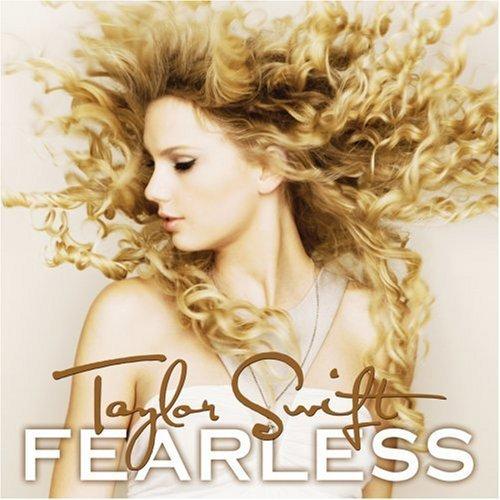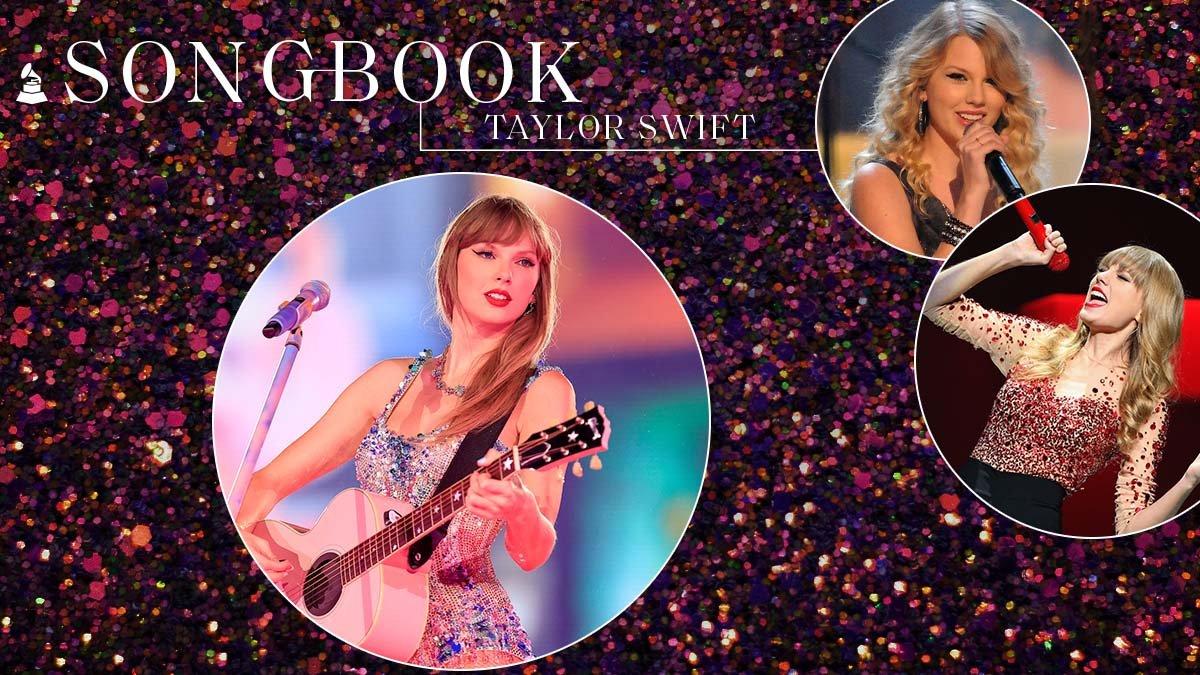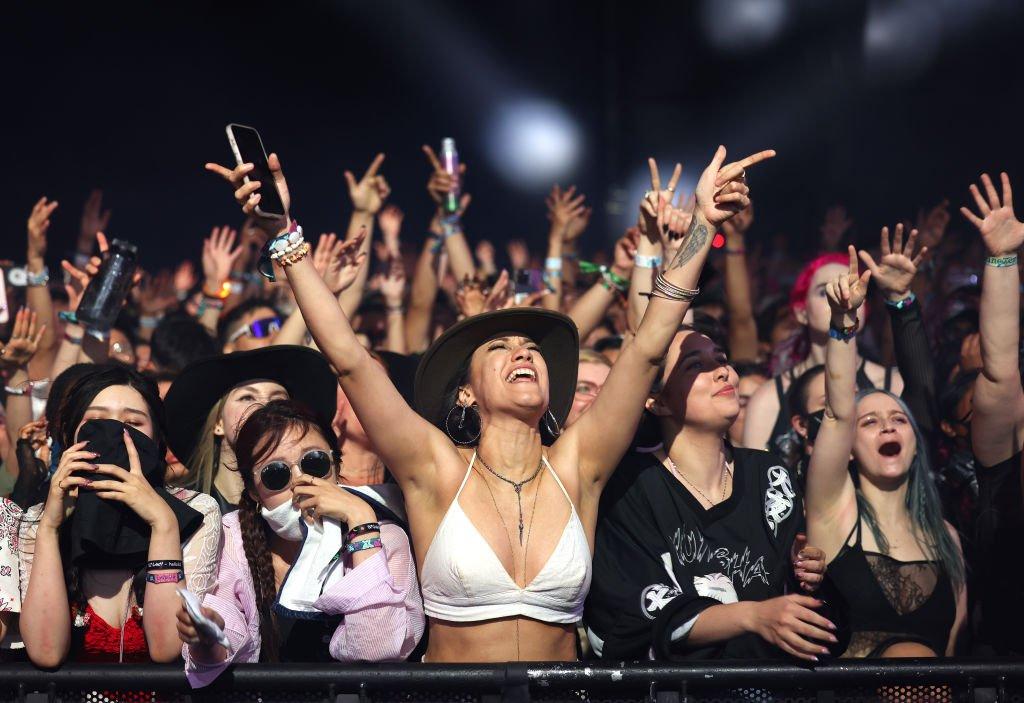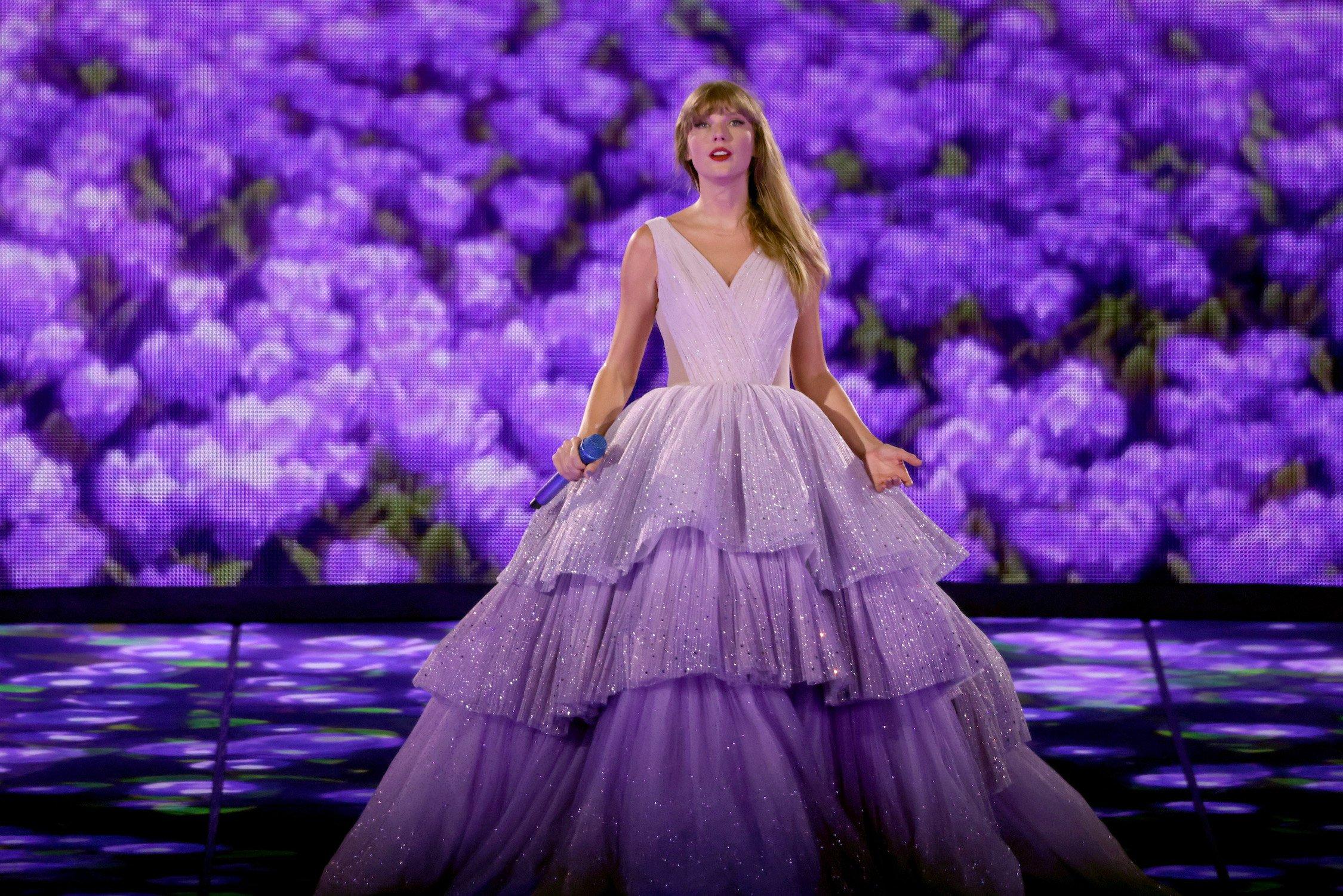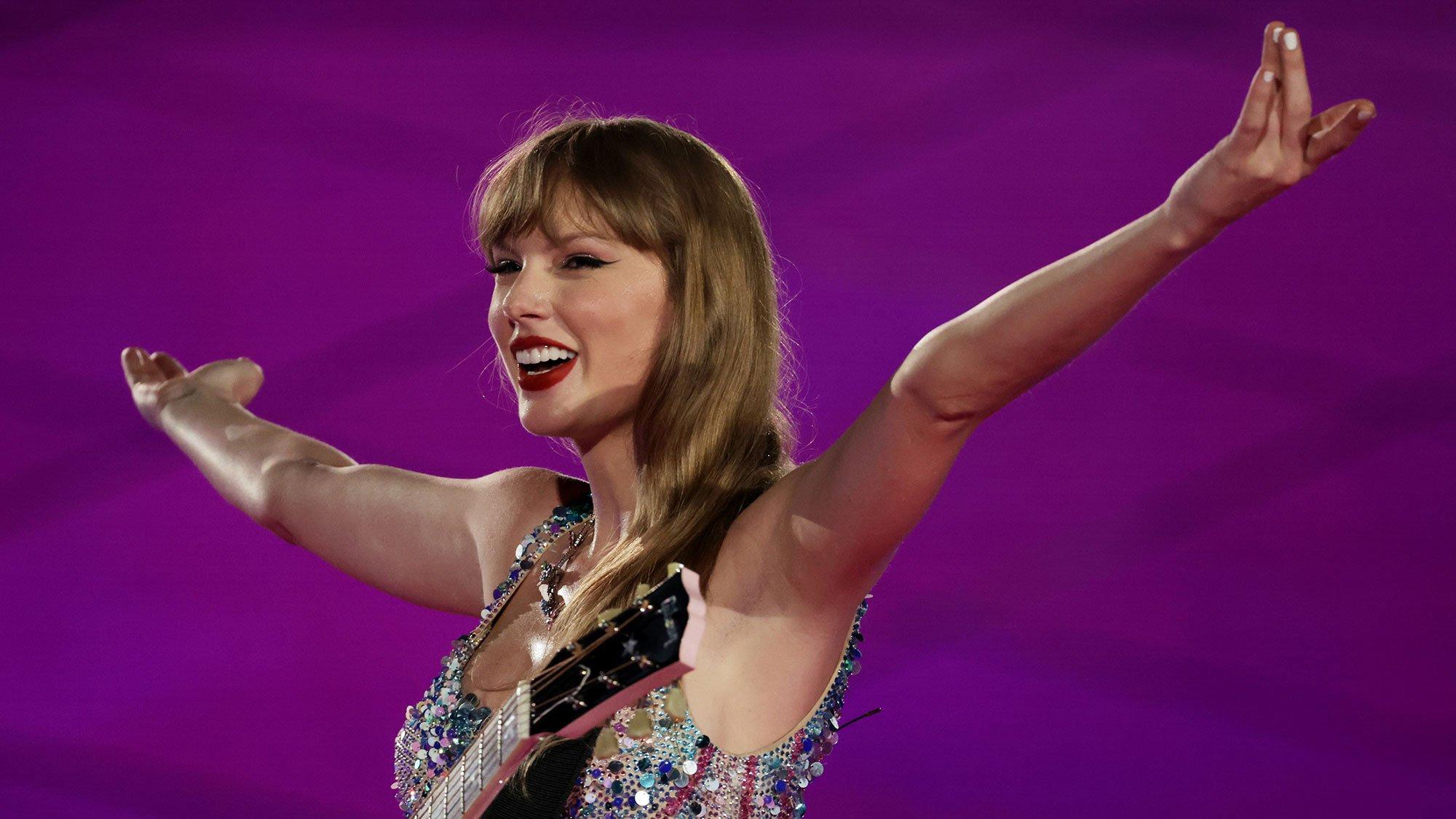The world now knows Taylor Swift as a global pop superstar, but back in 2006, she was just a doe-eyed country prodigy. Since then, she's released 10 (and soon to be 11) studio albums, re-recorded four as "Taylor's Version," and cultivated one of the most feverish fan bases in music. Oh, and she's also won 14 GRAMMY Awards, including four for Album Of The Year — the most ever won by an artist.
Swift has become one of music's most notable shapeshifters by refusing to limit herself to one genre, moving between country, pop, folk and beyond. A once-in-a-lifetime generational storyteller, one could argue that she is music's modern-day maverick, constantly evolving both her music and the culture around her.
Every album era has seen Swift reinvent herself over and over, which has helped pave the way for artists to explore other musical avenues. In turn, Swift hasn't just become one of the biggest artists of all time — she's changed pop music altogether.
Ahead of Taylor Swift's newest era with The Tortured Poets Department, GRAMMY.com looks back on all of her albums (Taylor's Versions not included) and how each era shaped her remarkable career.
Taylor Swift: Finding Her Place In Music
In a genre dominated by men, the odds were already stacked against Swift when she first broke into country music as a teenage female artist. The thing that differentiated her from other writers — and still does to this day — is her songwriting. She didn't want to be just "another girl singer" and knew writing her own songs would be what set her apart.
Written throughout her adolescence, Taylor Swift was recorded at the end of 2005 and finalized by the time Swift finished her freshman year of high school. Serving as a snapshot of Swift's life and teenhood, she avoided songwriting stereotypes typically found in country music. Instead, she wanted to capture the years of her life while they still represented what she was going through, writing about what she was observing and experiencing, from love and friendship to feeling like an outsider.
As a songwriter, Taylor Swift set the tone for what would be expected of her future recordings — all songs were written by her, some solely and others with one or two co-writers. One writer in particular, Liz Rose, applauded Swift's songwriting capabilities, stating that she was more of an "editor" for the songs because Swift already had such a distinct vision.
The album's lead single, "Tim McGraw," an acoustic country ballad inspired by Swift knowing her relationship was going to end, represents an intricate part of Swift's songwriting process; meticulously picking apart her emotions to better understand them. With its follow-up, "Our Song" — which spent six consecutive weeks on the top of Billboard's Hot Country Songs chart — she became the youngest person to solely write and sing a No. 1 country single; she also became the first female solo artist in country music to write or co-write every song on an album.
Although Swift's eponymous debut is underappreciated now — even lacking its own set on Swift's Eras Tour — Taylor Swift's forthcoming rerecording is arguably the most anticipated by fans, who are eager to hear the songs with the singer's current and more refined vocals. Still, for fans who haven't properly explored Taylor Swift, it's easy to tie together Swift's earlier work to her current discography.
On the track "A Place In This World," a song she wrote when she was just 13, Swift sings about not fitting in and trying to find her path. While her songwriting has developed and matured, feeling like an outsider and carving her own path is a theme she still writes about now, as seen on Midnights' "You're On Your Own, Kid."
Even as a new country artist, critics claimed that she "mastered" the genre while subsequently ushering it to a new era — one that would soon see Swift dabble in country-pop.
Fearless: Creating A Different Kind Of Fairytale
If Taylor Swift was the soundtrack to navigating the early stages of teenhood, Fearless is Swift's coming-of-age record. More than its predecessor, Fearless blurs the line between country and pop thanks to crossover hits like "Love Story" and "You Belong With Me," yet still keeps the confessional attributes known in country songwriting.
Most of Fearless is Swift coming to terms with what she believed love to be. On the album's liner notes, Swift says Fearless is about "living in spite" of the things that scare you, like falling in love again despite being hurt before or walking away and letting go. The 2008 version of Taylor wanted to "believe in love stories and prince charmings and happily ever after," whereas in Swift's Fearless (Taylor's Version) liner notes, she looks back on the album as a diary where she was learning "tiny lessons" every time there was a "new crack in the facade of the fairytale ending she'd been shown in the movies."
Much of Fearless also sees Swift being reflective and nostalgic about adolescence, like in "Never Grow Up" and "Fifteen." Still wistful and romantic, the album explores Swift's hopes for love, as heard in the album's lead single "Love Story," which was one instance where she was "dramatizing" observations instead of actually experiencing them herself.
Unlike the slow-burn of Taylor Swift, Fearless went straight to No. 1 on the Billboard 200 and stayed there for eight consecutive weeks. It won Swift's first Album Of The Year GRAMMY in 2010, at the time making her the youngest person to win the accolade at age 20. To date, it has sold 7.2 million copies in America alone. It might not be the romantic tale Swift dreamed of growing up, but her sophomore album signalled that bigger things were to come.
Speak Now: Proving Her Songwriting Prowess
Everything that happened after the success of Fearless pushed Swift from country music's best-kept secret to a mainstream star. But this meant that she faced more publicity and criticism, from naysayers who nitpicked her songwriting and vocals to the infamous Kanye West incident at the 2009 MTV Video Music Awards.
For the first time since becoming an artist, she was forced to reckon with the concept of celebrity and how turning into one — whether she wanted it or not — informed her own writing and perception of herself. No longer was she the girl writing songs like "Fifteen" in her bedroom — now she was working through becoming a highly publicized figure. Speak Now is the answer to those growing pains.
Along with having more eyes on her, Swift also felt pressured to maintain her persona as a perfect young female role model amid a time when her peers like Miley Cyrus and Demi Lovato were attempting to rebrand to be more mature and sexier. During her NYU commencement speech in 2022, she reflected on this era of her life as one of intense fear that she could make a mistake and face lasting consequences, so the songs were masked in metaphors rather than directly addressing adult themes in her music. But that also resulted in some of her most poignant lyrics to date.
Read More: For The Record: How Taylor Swift's 'Speak Now' Changed Her Career — And Proved She'll Always Get The Last Word
Writing the entire album herself, Swift used Speak Now to prove her songwriting prowess to those who questioned her capabilities. Much like her previous two albums, Swift included songs that were both inspired by her own life and being a fly on the wall. The album's title track pulled from the saying, "Speak now or forever hold your peace," inspired by a friend's ex-boyfriend getting engaged; meanwhile, "Mean" was everything Swift wanted to say to a critic who was continuously harsh about her vocals.
Retrospective and reflective, Speak Now is an album about the speeches she could've, would've and should've said. From addressing the aforementioned VMA incident in the forgiving "Innocent" to a toxic relationship in "Dear John," Speak Now also hinted that her rose-colored glasses were cracked, but Swift (and her songwriting) was only becoming stronger because of it.
Red: Coming Into Her Own
Highly regarded as Swift's magnum opus, Red sees the singer shed the fairytale dresses and the girl-next-door persona to craft a body of work that has now been deemed as her first "adult" record. On Red, Swift focused on emotions evoked from a hot-and-cold relationship, one that forced her to experience "intense love, intense frustration, jealousy and confusion" — all feelings that she'd describe as "red."
Unlike most of her previous writing that had been inspired by happy endings and fairytales, Red explores the lingering pain and loss that can embed itself within despite trying your hardest to let go. In her liner notes, she references Pablo Neruda's poem "Tonight I Can Write," stating that "Love is so short, forgetting is so long" is the overarching theme for the album. She plays with time — speeding it up in "Starlight," dabbling in the past in "All Too Well," and reframing it in "State of Grace" — to better understand her experiences.
After releasing country-pop records, Red toed the line between genres more than ever before. Swift leaned further into the full pop territory by working with esteemed producers Max Martin and Shellback for the dubstep-leaning track "I Knew You Were Trouble," the punchy lead single "We Are Never Getting Back Together," and the bouncy anthem "22." But even when the pop power players weren't involved, her country stylings still leaned more pop across the album, as further evidenced with the racing deep cut "Holy Ground" and the echoing title track.
The slight change of direction became polarizing for critics and fans alike. Following the more country-influenced Speak Now, some critics and fans found the pop songs on Red were too pop and the lyrics were too repetitive, possibly indicating that she might be selling out. If that wasn't enough, Red became an era where Swift's personal life went from speculation to tabloid fodder, with misogynistic headlines and diluting her work to just "writing about her exes." It's an era that would eventually inspire many tracks on Red's successor, 1989, like "Blank Space" and "Shake It Off."
Commercially, Red debuted at No. 1 on the Billboard 200 and sold 1.2 million copies in its first week, becoming the fastest-selling country album and making Swift the first female artist to have three consecutive albums spend six or more weeks at the top of the chart. The impact of Red extended beyond its own success, too. Often mentioned as a record that inspired a generation of artists from Troye Sivan to Conan Gray, Swift's confessional, soul-bearing authenticity set a new standard for straightforward pop music.
1989: Reinventing Into A Pop Genius
The night Red lost the GRAMMY for Album Of The Year in 2014, Swift decided that her next album would be a full-on pop record. After years of identifying as a country artist and flirting with pop, Swift departed her roots to reinvent herself, no matter what her then-label or critics had to say. And in true Swiftian fashion, turning into a pop artist didn't just prove her genre-shapeshifting capabilities — it further solidified her as an artist who is at her best when she freely creates to her desires and refuses to adhere to anyone.
1989 was lauded by critics for its infectious synth-pop that was reminiscent of the 1980s, yet still had a contemporary sound. Swift opted to lean more into radio-friendly hits, which resulted in songs like "Style," "Wildest Dreams," "Blank Space," and "Shake It Off," all of which became singles. And where some might trade a hit or two at the expense of their artistic integrity, Swift didn't falter — instead, her lyrics were just as heartfelt and intimate as they were on prior albums.
After exploring pop-leaning sonics she first found with Red, Swift worked with Martin and Shellback again on most of 1989. This reinvention brought new (and very important) collaborators as well. Swift's now-frequent collaborator Jack Antonoff credits her as the first person to take a chance on him as a producer with "I Wish You Would" and "Out Of The Woods"; both tracks exemplified how future Antonoff-produced songs would sound on albums like reputation, Lover and Midnights.
At the time, 1989 became Swift's best-selling album to date. It sold nearly 1.3 million copies within release week in the U.S., debuting atop the Billboard 200 and reigning for 11 non-consecutive weeks. The album also earned Swift several awards — including her second Album Of The Year GRAMMY, which made her the first female artist to ever win the award twice.
Following the release of 1989, Swift became a cultural juggernaut, and the album has had an omnipresence in music since. Swift didn't just normalize blending genres, but proved that you can create a sound that is uniquely yours by doing so. In turn, Billie Eilish, Dua Lipa and more pop stars have refused to conform or stick to what they've done prior.
reputation: Killing The Old Taylor
For years, Swift was on a strict two-year cycle — she'd release an album one year, tour the next, and then release a new album the following year. But following the heightened scrutiny and highly publicized tabloid drama that followed the end of the 1989 era, Swift completely disappeared for a year. She stayed away from public appearances, didn't do any press, and missed the album schedule fans became accustomed to. It wasn't until summer 2017 when she returned from her media (and social media) blackout to unveil the fitting title for her new album: reputation.
Born as a response to the naysayers and name-callers, reputation follows Swift shedding her public image — which includes the pressure to be perfect, the drama, and the criticism — by declaring, "There will be no further explanation. There will just be reputation." Leaning on the same tongue-in-cheek songwriting techniques she used while penning "Blank Space," Swift wrote from the mindset of how the public perceived her.
When Swift released the lead single "Look What You Made Me Do," a song she initially wrote as a poem about not trusting specific people, many assumed the album would center on vengeance and drama. Although Swift said that the album has its vindictive moments — even declaring that the "old Taylor" is dead on the bridge of "Look What You Made Me Do" — it's a vulnerable record for her. Swift described reputation as a bait-and-switch; at their core, the songs are about finding love in the darkest moments.
Swift still remained in the pop lane with reputation, largely leaning on Antonoff and the Martin/Shellback team. The sound almost mirrored the scrutiny Swift faced in the years prior — booming electropop beats, maximalist production and pulsing synthesizers dominate, particularly on "End Game," "I Did Something Bad," and "Ready For It…?" But the "old Taylor" isn't entirely gone on songs like "Call It What You Want," "So It Goes…" and "New Year's Day," where she lets her guard down to write earnest love odes.
Even after Swift spent some time away from the spotlight, the public didn't immediately gravitate toward her return. And even despite matching the 1.2 million first-week sales of her previous releases, some concluded that the album was her first commercial failure when compared to 1989. With time, though, it became clear that the response to reputation became muddled with the public's overall perception of her at the time — some even claimed that Swift was ahead of her time with the album's overall sound.
For her 2023 TIME Person of the Year profile, Swift described reputation as a "goth-punk moment of female rage at being gaslit by an entire social structure." For years, she felt the pressure to be "America's Sweetheart" and to never step out of line. Writing reputation became a lifeline following the events that catalyzed it — a way to shed the so-called snakeskin and make peace with however the public wanted to view her.
Lover: Stepping Into The Daylight
After finding love amongst chaos with reputation, Swift was learning to deal with the anxiety and fear of losing her partner — became a major theme of another aptly titled album, Lover. Both sonically and visually, Lover was a complete change from reputation. After touring reputation, Swift found that her fans saw her as "a flesh-and-blood human being," inspiring her to be "brave enough to be vulnerable" because her fans were along with her. Stepping away from the dark and antagonistic themes around reputation encouraged Swift to step into the light and be playful with her work on Lover.
Swift also found a new sense of creativity within this new mindset, one where she aimed to still embed playful themes in her songwriting but with less snark than that of "Blank Space" and "Look What You Made Me Do." Leaning into Lover being a "love letter to love," Swift explored every aspect of it. Tracks like "Paper Rings" and "London Boy" exude a whimsical energy, even if they center on more serious themes like marriage and commitment. Other songs, including "Death By A Thousand Cuts" and "Cornelia Street," are Swift at her most vulnerable, reflecting on a love lost and grappling with the extreme worry that comes when you could potentially lose someone.
Looking at Lover retrospectively, it's an album that almost symbolizes a bookend in her discography. She was playful yet poignant, picking apart her past lyrics and feelings and looking at them with the perspective of someone who was once on top of the world, hit rock bottom, and survived in spite of it. This evolution is mentioned throughout Lover, particularly in a direct callback to 2012's Red, "Daylight," which sees her describe her love as "golden" rather than "burning red."
Lover also marked the first time Swift divulged into politics and societal issues, like campaigning against Donald Trump, releasing the Pride-infused "You Need To Calm Down," and feeling disillusioned by the political climate with "Miss Americana & the Heartbreak Prince." Swift's documentary Miss Americana explores this change further, discussing how she regrets not being vocal about politics and issues prior, in addition to opening up about her body image issues and mental health struggles.
Lover became Swift's sixth No. 1 album in America, making her the first female artist to achieve the feat. But Lover was more than any accolades could reflect — it was Swift's transitional album in many ways, notably marking the first album that she owned entirely herself following leaving Big Machine Records for Republic Records in 2018.
folklore: Looking Beyond Her Personal Stories
After the pandemic started and Swift cancelled her Lover Fest, she spent the early stages of quarantine reading and watching a myriad of films. Without exactly setting out to create an album, she began dreaming of fictional stories and characters with various narrative arcs, allowing her imagination to run free. The result became folklore, 2020's surprise archetypal quarantine album.
Crafting a world with characters like the folklore love triangle between those in "betty" and "august," as well as Rebekah Harkness from "the last great american dynasty" (who once lived in Swift's Rhode Island mansion), was Swift's way of venturing outside her typical autobiographical style of writing. She'd see visceral images in her mind — from battleships to tree swings to mirrored disco balls — and turned them into stories, sometimes weaving in her own personal narrative throughout, or taking on a narrator role and speaking from the perspective of someone she had never met.
She worked remotely with two producers — again working with her right-hand man Jack Antonoff, and first-time collaborator Aaron Dessner from The National. Some songs, like "peace," were recorded in just one take, capturing the essence and fragility in the song's story, whereas the lyrics for the sun-drenched "august" were penned on the spot as Swift was in her makeshift home studio in Los Angeles.
Another aspect that separated folklore from her previous work was the obvious decision not to create hits made for radio play, so much so that Dessner claimed that she made an anti-pop record at a time when radio wanted clear "bops." Sonically, it ventured into genres Swift hadn't explored much outside of a few folkier tracks on Lover. Rather than relying on mostly electronic elements, Swift, Antonoff and Dessner weaved in soft pianos, ethereal strings, and plucky guitars.
folklore's impact on the zeitgeist at a time where everyone was stuck at home helped shape people's quarantine experience. Fans rejoiced at having songs to comfort them during difficult times, and artists like Maya Hawke, Gracie Abrams, and Sabrina Carpenter credit folklore for inspiring them to create and be even more emotionally honest in their songwriting. After its release, folklore became the best-selling album of 2020 after selling 1.2 million records. At the 2021 GRAMMYs, folklore took home Album Of The Year, making her the fourth artist in history to win three times in the Category.
evermore: Embracing Experimentation
It was exciting enough for Swifties to experience one surprise album drop from Swift, an artist who typically has an entire album campaign calculated. So when evermore was released just six months after folklore, fans were in shock.
Like its (literally) folklorian sister, evermore was a surprise release at the end of 2020, marking the first time Swift didn't have distinct "eras" between albums. She felt like there was something "different" with folklore, stating in a social media post that making it was less like she was "departing" and more like she was "returning" to the next stage of her discography. In turn, the album served as a similar escape for Swift as folklore did.
Bridging together the same wistful and nostalgic themes as heard on its predecessor, evermore sees Swift venture even further into escapism. She explores more stories and characters, some based in fiction like "dorothea," and some real, like "marjorie," written in dedication to Swift's grandmother.
Evermore follows folklore's inclusion of natural imagery and motifs, like landscapes, skies, ivy, and celestial elements. In contrast to the fairytale motifs and happy endings of Fearless, evermore saw Swift become fixated on "unhappy" endings — stories of failed marriages ("happiness"), lifeless relationships ("tolerate it"), and one-time flings ("'tis the damn season").
Sonically, evermore is a slight departure from its sister record; where folklore relies on more alt-leaning and indie-tinged sounds, evermore takes the sonics from all of Swift's past records — from pop to country to indie rock — and features all of them on one album. Country songs like "cowboy like me" and "no body, no crime" reaches back to Swift's earlier work in narrative building, seamlessly crafting a three-party story with ease. "Closure" is a "skittering" track that has the same energy as tracks like Lover's "I Forgot That You Existed," whereas the ballad "champagne problems" is thematically reminiscent of Swift's Speak Now track "Back To December" where she takes responsibility for her lover's heartache.
Working mostly with Dessner on evermore, Swift was emboldened to continue creating and opted to embrace whatever came naturally to them rather than limiting themselves to a sound. Swift felt a "quiet conclusion" after finishing up evermore, describing that it was more about grappling with endings of all "sizes and shapes," and the record represented a chapter closing. Even so, its poetic lyricism and mystical storytelling cleverly foreshadowed what was to come with subsequent albums, particularly The Tortured Poets Department.
Midnights: Encapsulating Her Artistic Magic
After coming out of the folklorian woods following folklore and evermore, fans and critics alike were intrigued to see what direction Swift would take on her next studio album. On Midnights, Swift leaves behind indie folk sounds and returns to the pop production of 1989 and Lover.
Her most conceptual album to date, Midnights charts 13 sleepless nights and explores five themes, from self-hatred and revenge to "what if" fantasies, falling in love, and falling apart. They are the things that keep her up at night, like the self-critiquing in "Anti-Hero," her rise to fame in "You're on Your Own, Kid," and the anxiety of falling in love again in "Labyrinth." Similarly to Swift's cheeky songwriting style that sees her create caricatures of herself in songs like "Blank Space" and "Look What You Made Me Do," she doubles down on claims she's "calculated" on "Mastermind," a song about devising a plan for her and her lover.
Although the album is a departure from the two pandemic sister albums, the overall creation process didn't differ too much. In addition to working alongside Antonoff (and bringing Dessner in for the bonus-track-filled 3am Edition), Swift's worldbuilding is still the throughline that connects Midnights and Swift's recent albums, whether she's dreaming of a Parisian escape in "Paris" or using war imagery as a metaphor for the struggle of love in "The Great War."
Read More: 5 Takeaways From Taylor Swift's New Album 'Midnights'
Following the success with folklore and evermore, Swift's intrigue was at a then-all-time high upon the release of Midnights. Along with breaking several streaming records — including becoming the first album to exceed 700 million global streams in a week — it was Swift's 11th No. 1 debut on the Billboard 200, and was the highest-selling album of 2022 (and, remarkably, the second best-selling of 2023).
To say that Swift's celebrity has become otherworldly since the release of Midnights would be an understatement. Celebrating her genre-defying and varied discography through The Eras Tour has resulted in old songs having a resurgence, new inside jokes and Easter eggs within the fandom, and a plethora of new listeners being exposed to Swift's work.
As a result, there has arguably never been more excitement for a Taylor Swift album than for The Tortured Poets Department — especially because the announcement came on the heels of her lucky 13th GRAMMY win in February. Midnights helped further solidify Swift's larger-than-life status at the finale of the 2024 GRAMMYs, too, as she became the only artist in history to win Album Of The Year four times.
The Tortured Poets Department: Check back on April 19!

